Top Tennis Strength and Conditioning Exercises
Aug 26, 2024
Looking to improve your tennis strength and conditioning? This article provides key exercises and training routines that focus on functional movements and building muscle mass to boost your power, agility, and endurance. Discover practical tips to elevate your performance and reduce injury risk on the court.
Key Takeaways
- An effective tennis strength and conditioning program focuses on overall fitness through exercises that enhance power, agility, and endurance, improving performance and reducing injury risk.
-
Periodization in training, which includes off-season foundational strength, early pre-season maximal strength, and late pre-season power and endurance phases, is essential for maintaining high performance levels throughout the year.
-
Incorporating a variety of exercises, including medicine ball slams, lunges with rotation, push-ups, goblet squats, and plyometrics like box jumps and jump squats, ensures comprehensive muscle development and functional strength specific to tennis movements.
-
Emphasizing muscle mass and functional movements is crucial for building the strength and agility needed for optimal tennis performance.
Understanding Tennis Strength and Conditioning
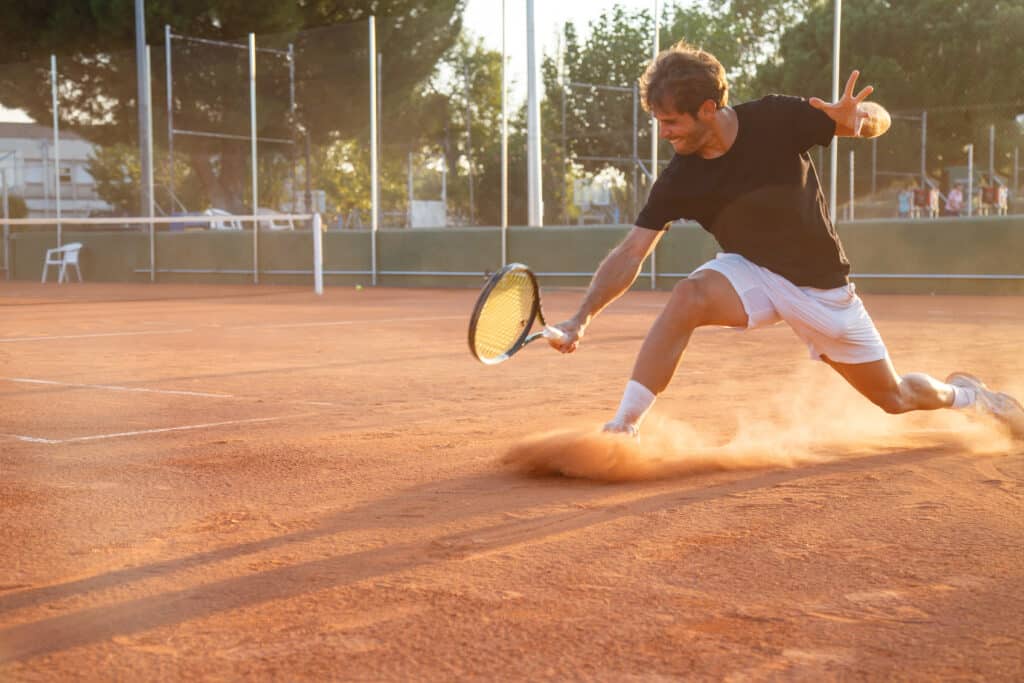 Tennis strength and conditioning programming to improve on court performance
Tennis strength and conditioning programming to improve on court performance
Tennis demands a potent mix of power, agility, and stamina. It requires not only the ability to hit the ball hard but also the capacity to sustain that intensity over lengthy rallies, matches, and tournaments. This is when a well-structured tennis strength and conditioning program becomes vital. Often, tennis is described as a power endurance sport, underlining the pivotal part strength and conditioning play in boosting court performance.
An inclusive tennis strength training program targets the development of multiple muscle groups, muscle mass, and functional movements crucial for player performance. The primary goal is to enhance physical fitness and overall gameplay. Top tennis players exhibit attributes such as strength and power in single and double leg/arm movements, rotational and anti-rotation strengths, and the capacity to swiftly absorb and produce force. Integrating these elements into your training regimen will build a stronger, more agile, and more prepared player.
The ultimate benefit of such a program is not just improved physical capabilities for the entire body, but also enhanced performance during matches, reduced risk of injuries, and increased confidence on the court.
Periodization in Tennis Strength Training
Periodization is vital to maximize the benefits of strength training for tennis. This strategic approach organizes training into phases, each with unique objectives, to boost an athlete’s possibility of attaining peak performance. For tennis athletes, this means setting distinct goals for each training phase and progressively building muscle mass and functional movements throughout the year. It enables players to concentrate on various types of strength, particularly power and endurance, while preventing fatigue and overtraining.
Unlike many other sports, tennis lacks an official off-season, requiring players to maintain multiple performance peaks throughout the year. Let’s explore the key phases of a periodized tennis strength training program.
Off-Season: Building a Strong Foundation
The off-season is a pivotal time for tennis players to establish the foundation for the forthcoming competitive season. The main objective during this phase is to build foundational strength, muscle mass, and focus on functional movements, setting the stage for more intense training phases in the future.
The off-season also includes a focus on broad motor development, which enhances overall athleticism. This is the time to address any weaknesses, improve general fitness, and develop a solid base of strength that will support the more specific and intense training to come. By dedicating time to building this strong foundation, players set themselves up for success in the subsequent phases of their training program.
Early Pre-Season: Increasing Maximal Strength
As players shift from the off-season to the early pre-season, the emphasis moves to building functional strength, muscle mass, and muscle bulk through a process called hypertrophy. This phase is essential for cultivating the maximal strength that underpins explosive power in later training cycles. Maximal strength is a fundamental element for tennis athletes, significantly boosting power, agility, and endurance on the court.
During this period, exercises are designed to increase a player’s ability to move loads at high velocity, setting the stage for the sport-specific power training to come. By emphasizing maximal strength development in the early pre-season, players build the necessary physical capacity to handle the demands of more intense, tennis-specific training in the later stages of their preparation.
Late Pre-Season: Power and Endurance
As the competitive season approaches, the late pre-season phase becomes critical for fine-tuning a player’s physical capabilities. This period focuses on tennis-specific exercises that effectively mimic the actual game’s movement patterns, combining strength and speed. The emphasis shifts to conditioning that prepares the body for the specific demands of tennis, particularly power endurance, muscle mass, and functional movements. During this phase, strength and endurance circuit exercises should be incorporated one to two times per week. It’s crucial to ensure that players are relatively recovered for each repetition and set to maximize the velocity of movement, which is key for developing explosive power. Weights used should not be too heavy, and rest periods should be sufficient to maintain the quality of each repetition.
This phase typically lasts one to two months, providing ample time to hone the power and endurance necessary for peak performance on the court.
Essential Strength Training Exercises for Tennis Athletes
 Tennis athletes use muscular endurance and weight training to perform at the highest levels
Tennis athletes use muscular endurance and weight training to perform at the highest levels
Understanding the significance of periodization, let’s examine the core exercises that underpin any potent tennis strength training program. Implementing a structured strength training routine is crucial for enhancing muscle mass, strength, and explosive power, leading to powerful serves, swifter court coverage, and expedited recovery between points.
Variety in your strength training routine is crucial to ensure all muscle groups are targeted, enhancing overall performance. Tennis strength training often includes compound exercises and multi-joint functional movements that mimic the demands of the sport. Let’s explore some key exercises that should be part of every tennis player’s strength training regimen.
Medicine Ball Slams
Medicine ball slams provide a robust exercise for tennis players, combining strength and explosive power training uniquely. This activity dramatically improves groundstrokes and serves by bolstering core strength, muscle mass, and power. The versatility of medicine ball exercises allows for a broad spectrum of functional movements, from fundamental to complex, imitating on-court actions. This specificity not only boosts performance, but also assists in injury prevention.
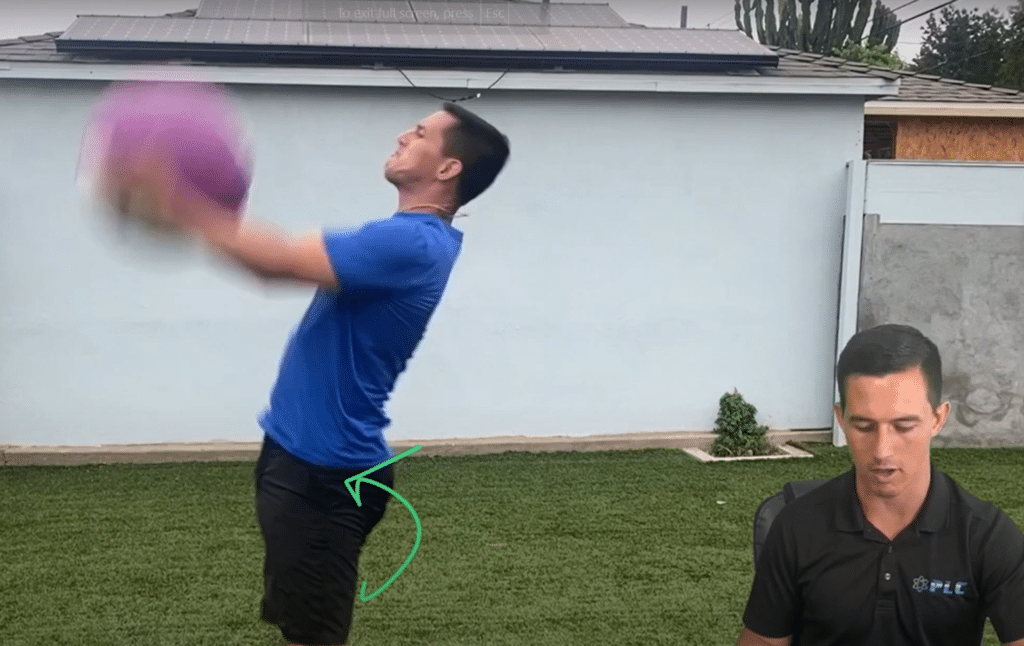 Tennis specific strength include medicine balls to target specific muscle groups and power training
Tennis specific strength include medicine balls to target specific muscle groups and power training
When incorporating medicine ball slams into your routine, focus on the key areas they target: serves, groundstrokes, and volleys. By simulating these tennis-specific movements with added resistance, you’re training your body to generate more power in these crucial aspects of your game. Remember to maintain proper form and gradually increase the weight of the medicine ball as your strength improves.
Lunge with Rotation
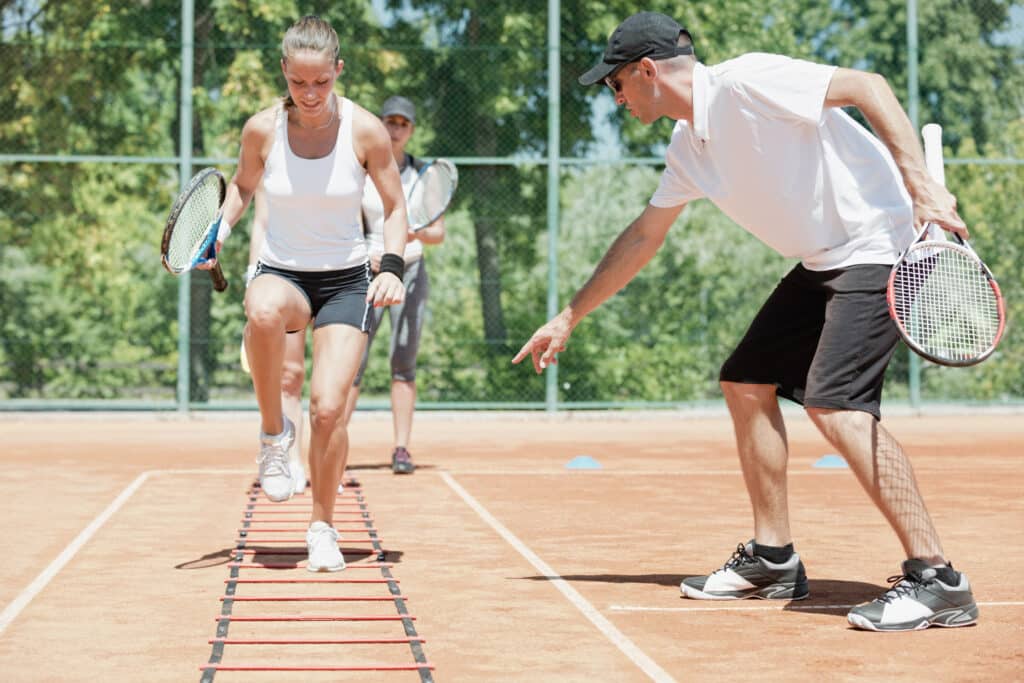 Tennis athletes use strength and conditioning coach to improve fast twitch muscle groups
Tennis athletes use strength and conditioning coach to improve fast twitch muscle groups
Lunge with rotation is a dynamic training exercise that tackles several aspects of tennis fitness in a single fluid motion. This exercise is fundamental for enhancing lower body strength, muscle mass, and rotational control, both important for tennis athletes. The rotational element is exceptionally beneficial as it aids in improving swift lateral movements and functional movements, crucial for efficient on-court performance. By targeting both lower body strength and rotational mobility, this exercise supports better balance, agility, and explosive movements during matches.
When performing lunges with rotation, focus on maintaining a stable core while twisting, mimicking the rotational forces experienced during groundstrokes. This exercise not only strengthens the legs but also improves hip mobility and core stability, all of which contribute to more powerful and controlled movements on the tennis court.
Push-Ups and Pull-Ups
Push-ups and pull-ups are foundational exercises that should be included in every tennis athlete strength training routine. Building upper body strength and muscle mass through these functional movements are crucial for tennis athletes, as they target the key muscle groups used in serving and groundstrokes. These exercises significantly enhance the power behind serves and groundstrokes, aiding players in generating more force in their shots. Moreover, incorporating push-ups and pull-ups into your routine can help prevent injuries by strengthening the muscles around the shoulders and upper back.
 Tennis athletes need agility and power training to withstand the demands of the sport
Tennis athletes need agility and power training to withstand the demands of the sport
Push-ups are particularly beneficial for improving the chest, shoulders, and triceps, which are crucial for tennis players. Pull-ups, on the other hand, target the back muscles and biceps, enhancing overall upper body strength and stability. By consistently performing these exercises, you’ll notice improvements in your serve power, shot consistency, and overall endurance during long matches.
Goblet Squats
Goblet squats offer a flexible and efficient lower body exercise with many benefits for a tennis athlete. This activity targets several muscle groups at once, including:
-
Glutes
-
Quads
-
Hamstrings
-
Core
Goblet squats are especially beneficial for tennis athletes to build tennis specific strength and muscle mass, crucial for powerful court movements and muscular endurance.
One of the key advantages of goblet squats is that they help maintain a neutral spine and keep the chest up, promoting good posture and reducing the risk of injury. To perform a goblet squat:
-
Hold a weight (such as a dumbbell or kettlebell) close to your chest.
-
Squat by bending your knees and pushing your hips back.
-
Drive through your heels to return to the starting position.
This exercise not only strengthens the legs but also improves overall stability and balance, translating to better footwork and more explosive movements during matches.
Incorporating Jump Training into Your Routine
Moving beyond traditional tennis strength training, it’s vital to include jump training in your tennis conditioning routine. Tennis’s fast-paced nature requires exercises like plyometrics for enhancing muscular power, muscle mass, and reaction time. Plyometric exercises are specifically designed to increase power output, elasticity, tissue tolerance, and functional movements, all of which are crucial for highly competitive tennis. These exercises enhance neural drive and intermuscular coordination, vital components for the explosive movements required in tennis.
It’s important to note that both lower-body and upper-body plyometric exercises can significantly enhance overall performance in elite athletes, not just for jumps but also for powerful strokes. Let’s explore some key tennis specific exercises that can create a balanced physique.
Box Jumps
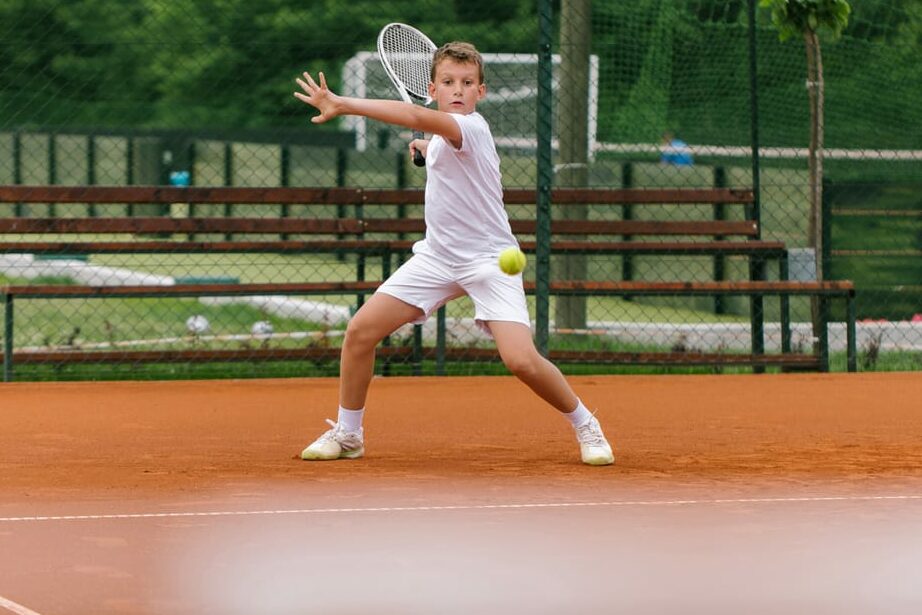 Tennis strength and conditioning should include lateral movement and stability to improve performance
Tennis strength and conditioning should include lateral movement and stability to improve performance
Box jumps are a key part of jump training for tennis athletes, providing several benefits that directly enhance on-court performance. This exercise is especially efficient at building explosive power and muscle mass, which are crucial for functional movements such as jumping, sprinting, and changing directions on the court. Box jumps primarily utilize the fast component of the stretch-shortening cycle (SSC), which is crucial for quick, explosive movements in tennis athletes. By incorporating box jumps into your routine, you can significantly enhance your maximal strength and hamstring muscles.
Moreover, these exercises improve balance and coordination, which directly translate to better muscular endurance for competitive tennis. A tennis strength training program that includes power training will increase performance during a long rally and explosive serve.
Jump Squats
Jump squats are a powerful power training exercise that is essential to all tennis strength training program. This exercise is particularly effective for tennis athletes as it enhances both muscle mass and functional flexibility, directly improving court movements and jumps.
Jump squats are beneficial for tennis players because they combine lower body strength training with explosive power development. This combination is crucial for enhancing the explosive power and agility necessary for quick starts, stops, and direction changes on the tennis court.
When performing jump squats, it’s important to maintain proper form throughout the movement. Start in a squat position, explode upwards into a jump, and land softly back into the squat position. Remember to warm up properly before engaging in any plyometric exercises, with a recommended warm-up duration of about 10 minutes before each power training session.
Medicine Ball Throws
Incoporating Medicine balls are excellent tennis specific exercises that targets the upper body power crucial for tennis athletes. These exercises are particularly effective in increasing power in the upper body, which is essential for high-velocity serves and powerful groundstrokes. Additionally, medicine ball throws help build muscle mass and improve functional movements, enhancing coordination between the upper and lower body—a vital component for executing complex tennis movements efficiently.
When incorporating medicine ball throws into your routine, focus on exercises that mimic tennis-specific movements. For example, you can perform rotational throws to simulate forehand and backhand swings, or overhead throws to enhance your serve power. By consistently practicing these exercises, you’ll notice improvements in your shot power, serve velocity, and overall upper body strength, all of which contribute to a more dominant presence on the court.
Core Strengthening for Tennis Athletes
A robust core underpins every successful tennis player’s physical capabilities. Muscular and resilient core muscles are vital for competitive tennis athletes as they aid in efficient energy transfer, support substantial rotational movements, and contribute to overall muscle mass. Incorporating movements with a rotational emphasis is essential for maintaining postural control and stability in tennis, considering the sport’s strength endurance. Some exercises to strengthen your core for tennis include:
-
Plank variations
-
Russian twists
-
Medicine ball throws
-
Cable rotations
-
Bicycle crunches
Incorporating these exercises into your training routine will help improve your performance on the tennis court.
A well-conditioned core ensures that your shots are consistently on point and precise, even during long, grueling matches. Let’s explore some effective core strengthening exercises that you should include in your tennis strength training program.
Plank Variations
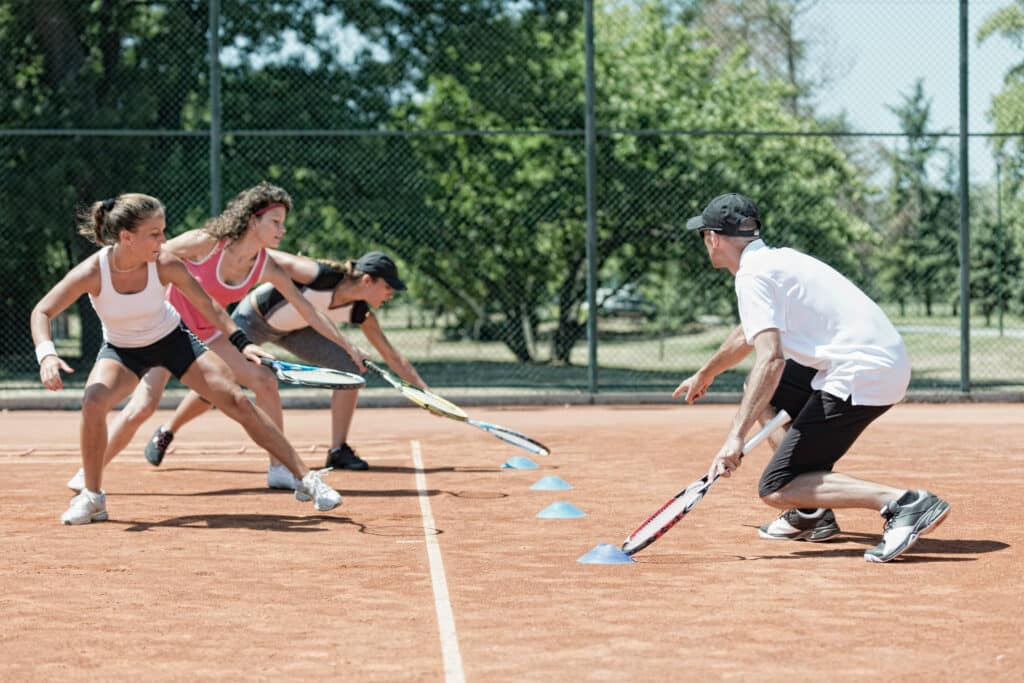 Tennis conditioning sessions incorporating tennis specific exercises
Tennis conditioning sessions incorporating tennis specific exercises
Planks offer a flexible and highly effective exercise for developing core strength and muscle mass, with their variations targeting different facets of core stability and functional movements essential for tennis players. Forearm planks, side planks, and reverse planks are especially useful in working core muscles for a tennis player.
Side planks with leg raises are especially beneficial as they target the lateral core muscles, improving side-to-side stability necessary for quick lateral movements on the court. To increase the difficulty and effectiveness of side planks, try lifting the top leg while maintaining a stable position. This variation further challenges your balance and engages more of your core muscles.
For an added challenge, incorporate active planks with arm raises or plank opposites. These dynamic variations not only enhance core stability but also challenge your balance and coordination, mimicking the demands of quick, multi-directional movements in tennis.
Russian Twists
Russian twists are a robust exercise for a tennis athlete, focusing on the frequently overlooked oblique muscles. This activity is vital for training oblique muscles, which serve a crucial function in generating power for efficient forehand shots. Additionally, Russian twists help build muscle mass and improve functional movements, which are essential for overall athletic performance. Russian twists not only enhance shot power but also significantly improve rotational control and agility, essential for performing quick lateral movements on the court.
When performing Russian twists, follow these steps:
-
Sit on the ground with your knees bent and feet slightly lifted off the floor.
-
Lean back slightly to engage your core.
-
Twist your torso from side to side while holding a weight or medicine ball.
-
Focus on controlled, deliberate movements rather than speed.
-
As you become more comfortable with the exercise, you can increase the weight or add a slight bounce as you twist to further challenge your core stability.
By consistently incorporating Russian twists into your routine, you’ll notice improved rotational power in your shots and enhanced ability to change directions quickly during rallies.
Stability Ball Exercises
Incorporating a stability ball into your core workout routine can significantly enhance your balance, muscle mass, and overall stability on the tennis court. Stability ball exercises are particularly effective for tennis players as they help improve core balance, functional movements, and overall stability, which are crucial for maintaining proper form and balance during intense rallies and quick directional changes.
Some effective stability ball exercises for a tennis player include stability ball crunches, stability ball planks, and stability ball pike ups. These exercises not only target your core muscles but also engage smaller stabilizing muscles that are often overlooked in traditional core workouts. By challenging your balance on an unstable surface, stability ball exercises force your core to work harder, leading to improved balance, coordination, and overall core strength.
Remember to start with basic exercises and gradually progress to more challenging variations as your core strength and stability improve.
Flexibility and Mobility Exercises
While strength and power are vital in tennis, flexibility, mobility, muscle mass, and functional movements hold equal importance for optimal performance and injury prevention. Flexibility and mobility exercises are essential for tennis players to avoid injuries and enhance court performance. These activities improve the range of motion, facilitating more fluid and efficient movements during play. Maintaining sufficient flexibility helps prevent injuries by avoiding excessive muscle stretching and damage such as muscle tears.
Good flexibility enables faster movement and facilitates proper court positioning, giving you a competitive edge during matches. Let’s explore some key flexibility and mobility exercises that should be part of every tennis player’s routine.
Dynamic Stretching
Dynamic stretching is an integral part of every tennis player’s warm-up routine. Unlike static stretching, dynamic stretching highlights movement and fluidity, readying the body for tennis by ensuring it remains loose across various movement planes. This type of stretching is particularly beneficial as it prepares muscles by increasing body temperature and heart rate, effectively readying the muscles for high-intensity play and dynamic movements. Additionally, dynamic stretching helps build muscle mass and incorporates functional movements, which are essential for a comprehensive training program. Dynamic stretches also improve coordination and wake up the nervous system before a match, ensuring you’re mentally and physically prepared to perform at your best.
When performing dynamic stretches, it’s important to maintain control with engaged abs and practice deep breathing. By incorporating dynamic stretching into your pre-match routine, you can significantly reduce the risk of injuries by increasing flexibility and range of motion. Some effective dynamic stretches for a tennis athlete include:
-
Arm circles
-
Leg swings
-
Walking lunges with a twist
-
High knees
Yoga for Tennis Players
Yoga provides a multitude of benefits for a tennis player, making it an excellent addition to traditional strength and conditioning programs. Regular yoga practice can significantly enhance flexibility, muscle mass, and functional movements, which are key components for success on the tennis court. The improved flexibility acquired through yoga directly contributes to better tennis performance, enabling a greater range of motion in serves, volleys, and groundstrokes.
Moreover, the mental focus cultivated through yoga practice can be a game-changer for tennis athletes, helping them stay calm and centered during high-pressure moments in matches. Incorporating yoga into your routine doesn’t have to be time-consuming; even 15-20 minutes of practice a few times a week can yield significant benefits. Focus on poses that target areas commonly tight in tennis players, such as hip openers, shoulder stretches, and spinal twists.
As an added bonus, the mindfulness aspect of yoga can help reduce stress and improve overall well-being, contributing to better recovery and performance both on and off the court.
Injury Prevention Strategies
In the realm of tennis, avoiding injuries is equally important as enhancing performance. Injury prevention is vital in tennis to maintain steady performance and extend athletic careers. One essential strategy is strengthening core muscles and increasing muscle mass, which can prevent overuse injuries due to the sport’s high demand for rotational and functional movements. By fortifying muscles around joints, we can stabilize them and reduce strain on ligaments and cartilage, thereby decreasing the risk of injuries.
Some key exercises to strengthen core muscles for injury prevention in tennis include:
-
Plank variations
-
Russian twists
-
Medicine ball throws
-
Side plank variations
-
Bicycle crunches
Incorporating these exercises into your training routine can help you build a strong core and reduce the risk of injuries on the tennis court.
It’s also important to note that using correct tennis techniques can prevent overuse injuries like tennis elbow and rotator cuff tears. Let’s explore some specific strategies to keep you healthy and on the court.
Rotator Cuff Strengthening
The rotator cuff muscles play a crucial role in the powerful and repetitive shoulder movements required in tennis, making their strengthening a top priority for injury prevention. Strengthening the rotator cuff not only helps in building muscle mass but also enhances functional movements, significantly reducing the risk of tennis elbow and other shoulder injuries that commonly plague tennis players. One effective exercise is the shoulder external rotation with a towel underarm. This exercise targets the external rotators of the shoulder, which are often neglected but crucial for maintaining shoulder health.
Some beneficial exercises for strengthening the rotator cuff are:
-
Straight-arm banded walk-out: enhances rotator cuff stability while engaging the core
-
Prone ‘Y’ exercise: targets the rotator cuff and improves overall shoulder function
-
External rotation exercises with resistance bands: effectively strengthens the rotator cuff
Remember to start with light resistance and focus on proper form, gradually increasing the difficulty as your strength improves.
Wrist and Forearm Conditioning
Wrist and forearm strength is crucial for a tennis player, not only for generating power in shots but also for preventing common injuries like tennis elbow. Building muscle mass and incorporating functional movements into your training can enhance overall performance. Weighted static holds are an excellent exercise to improve wrist stability by strengthening forearm muscles. To perform this exercise, hold a light dumbbell or weight plate with your arm extended and wrist cocked back, maintaining this position for 20-30 seconds.
Some effective exercises for strengthening the wrists and forearms include:
-
Hammer drill: Rotate the hand while holding a hammer or light dumbbell to enhance wrist stability.
-
Wrist flexor exercises: Move the wrist up and down with a lightweight or elastic band to strengthen the wrists and forearms.
-
Grip strength exercises: Improve grip strength, which is essential for maintaining control of the racquet during powerful shots.
These exercises will help you improve your overall performance on the court.
Incorporate these weight training exercises into your routine 2-3 times a week, gradually increasing the weight or resistance as your strength improves.
Lower Body Strengthening
A strong lower body is the foundation of powerful and injury-resistant tennis play. Strengthening the lower body, particularly the hip flexors and posterior chain, is crucial for tennis players to avoid common lower body injuries. Additionally, focusing on muscle mass and functional movements can enhance overall performance and resilience.
Some exercises that can help improve your tennis game are:
-
Single-leg squats: These strengthen the hip flexors and posterior chain, improving stability and power generation.
-
Resistance band exercises: These target and strengthen the muscles around the hips and lower back, areas that are often stressed during tennis play.
-
Walking lunges: These improve balance and leg strength, which are essential for quick movements on the court.
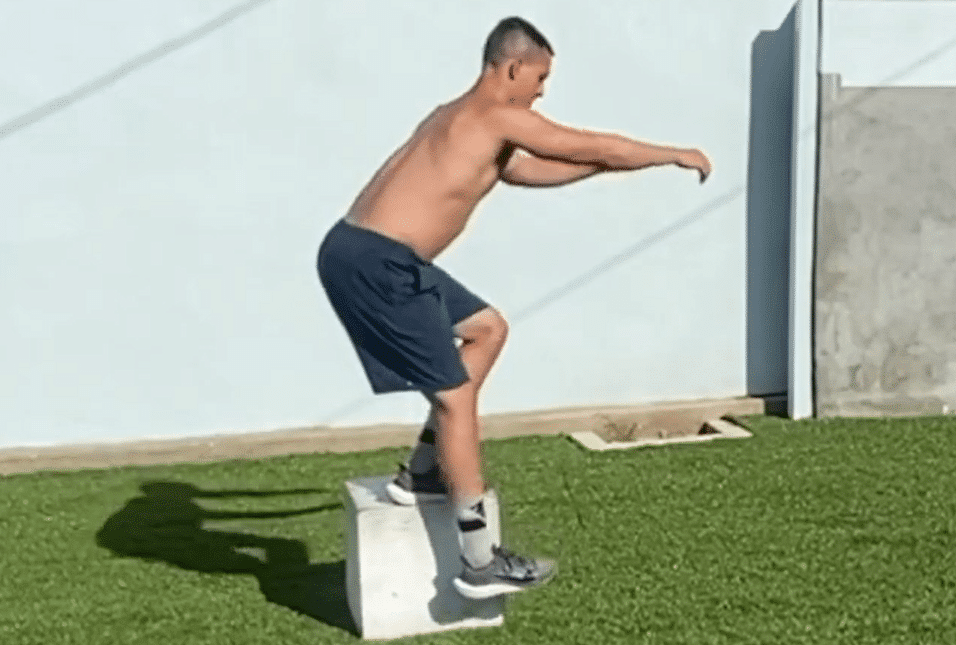 Tennis athletes should be doing single leg exercises for added stability and muscular endurance
Tennis athletes should be doing single leg exercises for added stability and muscular endurance
Incorporating exercises with a stability ball can strengthen key muscle groups in the legs and improve knee ligament stability, which is crucial for the quick directional changes in tennis. Some exercises to try include:
-
Squats
-
Lunges
-
Hamstring curls
-
Calf raises
Lastly, side lunges are effective for stretching and strengthening the muscles around the legs, enhancing lateral movement capabilities. By consistently incorporating these lower body strengthening exercises into your routine, you’ll build a solid foundation for powerful, injury-resistant tennis play.
Developing Cardiovascular Fitness
Cardiovascular fitness is a fundamental aspect of tennis performance, playing a critical role in a player’s capacity to sustain high-intensity efforts throughout lengthy matches. Stamina is essential for keeping a high level of performance during extended matches, and cardiovascular fitness, along with muscle mass and functional movements, is key to preserving energy and performance throughout demanding tournaments. High aerobic capacity is especially important for tennis players as it aids in quick recovery between points, helps maintain focus, and enables players to endure long, intense matches. By developing strong cardiovascular fitness, players can maintain playing intensity throughout long matches and tournaments, giving them a significant edge over their opponents.
Let’s explore some effective methods for improving cardiovascular fitness specifically for tennis players.
Interval Training
Interval training is a potent tool for tennis players aiming to enhance their cardiovascular fitness, muscle mass, and match stamina. High-Intensity Interval Training (HIIT) can significantly boost VO2 max, which is crucial for sustained aerobic performance in tennis. By incorporating functional movements, HIIT offers comprehensive benefits for tennis players:
-
Mimics the stop-start nature of tennis matches
-
Improves cardiovascular endurance
-
Increases speed and agility
-
Enhances anaerobic capacity
-
Burns calories and promotes weight loss
Incorporating HIIT into your training routine can help you take your tennis game to the next level.
Moreover, this type of training promotes anaerobic endurance, helping players maintain explosive power during high-intensity rallies. For optimal results, it’s recommended that racket sports athletes include HIIT in their training three times a week for 30–40 minutes, over a period of six to eight weeks. A sample HIIT workout for tennis players might include exercises like burpees, mountain climbers, and high knees, performed in short bursts with brief rest periods in between.
Remember, the key to effective interval training is maintaining high intensity during the work periods to maximize cardiovascular benefits.
Steady-State Cardio
While interval training is crucial for tennis-specific fitness, steady-state cardio still has an important place in a well-rounded training program. Steady-state cardio helps improve cardiovascular endurance, muscle mass, and aerobic fitness, which are crucial for long and continuous physical activity in tennis. Incorporating functional movements into your routine can further enhance overall performance. This type of training allows tennis players to:
-
Sustain energy levels during prolonged matches, a critical factor in tournaments where players may have to compete in multiple matches over several days
-
Have high aerobic capacity, aiding in quick recovery between points
-
Maintain continuous concentration and performance throughout a match.
Activities like jogging, cycling, or swimming at a moderate intensity for 30-60 minutes can be effective forms of steady-state cardio for tennis players. The key is to maintain a consistent heart rate in the aerobic zone (about 70-80% of your maximum heart rate) throughout the session. By incorporating steady-state cardio into your training routine, you’ll build the endurance necessary to maintain high performance levels from the first serve to the final point.
Court-Specific Drills
To truly optimize cardiovascular fitness for tennis, it’s essential to incorporate court-specific drills that mimic the demands of actual match play. These drills are crucial for tennis players as they simulate match conditions, helping to improve performance by practicing relevant movements and scenarios directly on the court. Additionally, focusing on muscle mass and functional movements ensures a comprehensive training program that enhances overall athleticism.
Court-specific cardiovascular drills should include on-court sprints and shuttle runs that replicate the intermittent high-intensity bursts typical of a tennis match. These exercises are particularly effective in improving a player’s ability to sustain high performance levels throughout long matches.
Agility drills such as ladder drills, cone drills, and footwork patterns are also crucial for enhancing a player’s quickness and reaction time on the court. These exercises help players effectively change directions and improve their overall movement and positioning during rallies.
By regularly practicing these court-specific drills, you’ll not only improve your cardiovascular fitness but also enhance your tennis-specific movements and decision-making skills under fatigue, giving you a significant advantage during matches.
Creating a Balanced Training Schedule
Creating a balanced training schedule is crucial for tennis players to optimize performance and avoid burnout. Incorporating ‘muscle mass’ development and ‘functional movements’ into your routine is essential to ensure a comprehensive training program. Having sufficient rest days is essential to prevent fatigue and overtraining, which can result in diminished performance and increased injury risk. Balancing training with adequate rest helps to:
-
Prevent injuries
-
Ensure consistent performance improvement over time
-
Alternate between high-intensity workouts and lighter sessions to ensure adequate recovery
Careful scheduling of training and rest days helps in maintaining consistent performance levels throughout the season, allowing players to peak at the right times for important tournaments. Let’s delve into the key components of creating a balanced training schedule that will help you maximize your tennis performance.
Integrating Rest and Recovery
Rest and recovery are more than just passive components of a training schedule; they are active and essential elements that significantly contribute to a player’s overall performance and longevity in the sport. Proper rest and recovery help prevent overtraining, promote muscle growth, and reduce the risk of injury. Additionally, they play a crucial role in maintaining muscle mass and improving functional movements, which are vital for a well-rounded training program. It’s particularly important to be aware of the signs of overtraining, which can lead to physical, behavioral, and emotional issues. This is especially common among young tennis players due to inadequate communication about their condition. To avoid overtraining, it’s crucial to monitor how players feel daily and adjust their training schedules accordingly.
This might involve adjusting training intensity and volume based on personal recovery rates. During the off-season, focus on rest, emotional and physical renewal, and participating in activities that bring joy outside of tennis. Remember, proper recovery enhances muscle repair and growth, which is essential for continual progress in training. Rest days are not just about physical recovery; they also provide emotional benefits after intense training sessions, helping to maintain motivation and prevent burnout.
Customizing Your Program
While general guidelines are useful, the most effective training programs are those customized to the individual player’s needs and goals. Training programs should be personalized to accommodate each player’s unique needs, physical tolerances, and goals, including building muscle mass and improving functional movements. When customizing a tennis training program, it’s important to consider factors like age, current fitness level, and specific performance goals.
A well-rounded program should include both on-court practice and off-court fitness training, with the balance adjusted based on individual needs and maturation rates. Training intensity should be adjusted based on personal fitness levels and goals to ensure optimal results without risking overtraining or injury. Some players might need to focus more on agility training, while others might require additional strength or endurance work.
Regular assessments and open communication between the player, coach, and any fitness trainers involved are crucial for continually refining and optimizing the training program. Remember, the goal is to create a program that not only improves performance but also sustains long-term development and enjoyment of the sport.
Summary
As we wrap up our comprehensive guide to top tennis strength and conditioning exercises, it’s clear that a well-rounded approach is key to maximizing performance on the court. We’ve explored the importance of periodization in structuring your training, delved into essential strength exercises that target key muscle groups, and highlighted the role of plyometrics in developing explosive power. We’ve also emphasized the critical nature of core strength, flexibility, and injury prevention strategies. Cardiovascular fitness, often overlooked in favor of skill work, has been shown to be crucial for maintaining high performance levels throughout long matches. Additionally, building muscle mass and incorporating functional movements are essential for enhancing overall athleticism and on-court performance. Finally, we’ve stressed the importance of creating a balanced training schedule that includes adequate rest and recovery. Remember, the journey to becoming a better tennis player is ongoing, and consistency is key. By incorporating these exercises and strategies into your routine, you’re not just working towards improving your game; you’re investing in your long-term health and enjoyment of the sport. So, step onto the court with confidence, knowing that your off-court work is setting you up for success. Your opponents won’t know what hit them!
Frequently Asked Questions
How often should I incorporate strength training into my tennis routine?
Incorporate strength training into your tennis routine 2-3 times per week for optimal results, adjusting the intensity and volume based on your competition schedule to allow for adequate recovery while promoting consistent strength gains.
Can plyometric exercises really improve my on-court performance?
Yes, plyometric exercises can improve your on-court performance by enhancing explosive power and quick reaction times, crucial for tennis. Adding exercises like box jumps and medicine ball throws can significantly boost power generation and agility for better on-court performance.
I’m concerned about developing bulky muscles that might hinder my flexibility. How can I avoid this?
To avoid developing bulky muscles that might hinder flexibility, focus on exercises promoting functional strength and explosive power rather than muscle growth. Additionally, incorporate flexibility work and maintain a balanced diet to enhance your performance without building bodybuilder-style muscles.
How important is cardiovascular fitness for tennis, and what’s the best way to improve it?
Cardiovascular fitness is crucial for tennis as it helps maintain high performance levels and quick recovery between points. The best way to improve it is by combining high-intensity interval training, steady-state cardio, and court-specific drills. This combination helps improve aerobic and anaerobic capacities, closely mimicking the demands of a tennis match.
I’m prone to tennis elbow. Are there specific exercises I should do or avoid?
Focus on strengthening the forearm, wrist, and shoulder muscles with exercises like wrist curls and rotator cuff strengthening. Avoid exercises that put excessive strain on the elbow joint and seek professional advice if the pain persists.
Stay connected with news and updates!
Join our mailing list to receive the latest news and updates from our team.
Don't worry, your information will not be shared.
We hate SPAM. We will never sell your information, for any reason.

